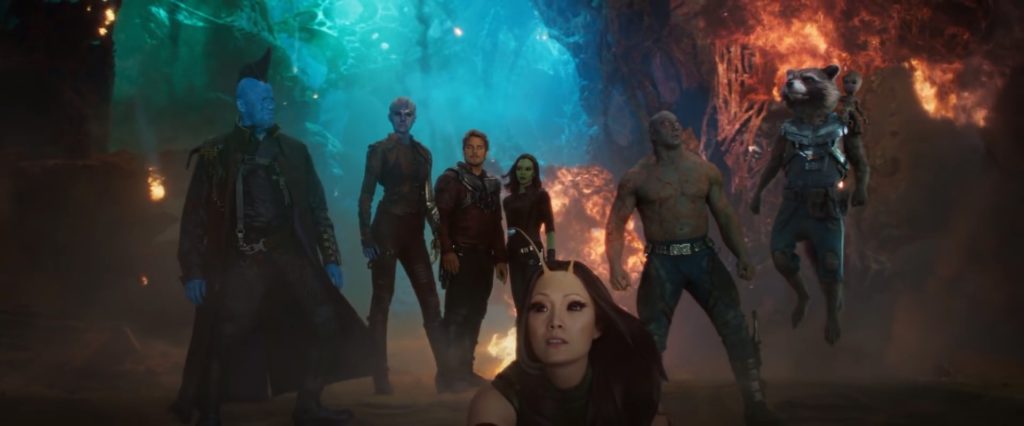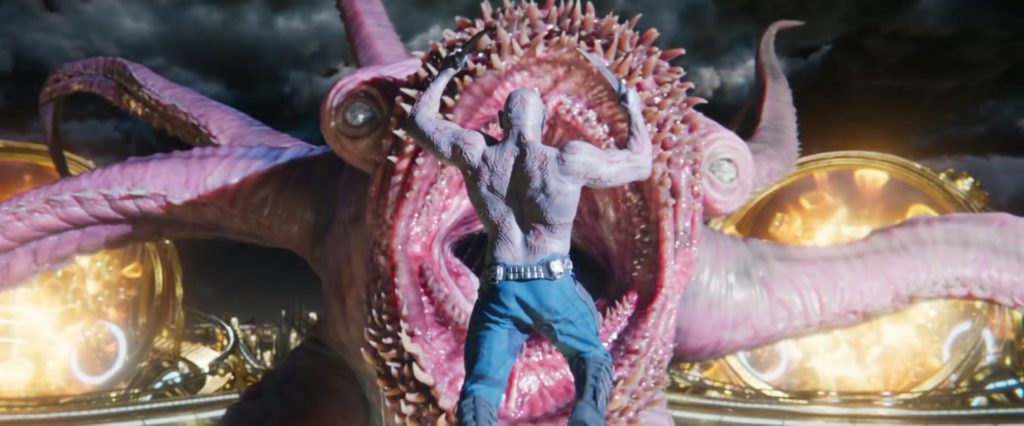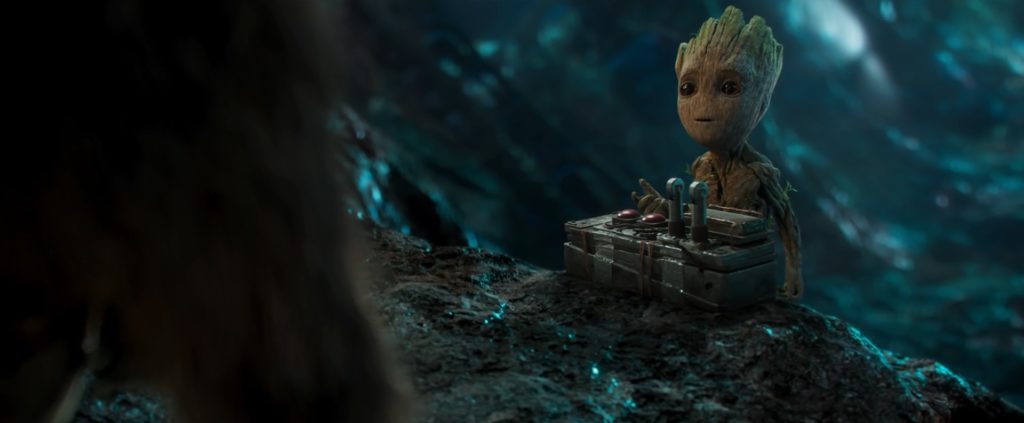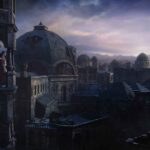In this weekly series, we chronicle the long road undertaken by the Marvel Cinematic Universe movies to arrive at Avengers: Infinity War. We introspect and discuss the movies from a critical and commercial standpoint while also considering the development efforts that went behind them. These articles may be occasionally sprinkled with spoilers so please make sure to skip the relevant sections when reading.
This post is about the 2017 movie Guardians of the Galaxy Vol. 2, the fifteenth chapter in the Marvel Cinematic Universe. To check out other entries in our Road to Infinity War series, click here.
You’d wager a movie has wit oozing out of it when it’s titled Guardians of the Galaxy Vol. 2, after the Awesome Mix Vol. Tapes that so made the first Guardians of the Galaxy a household name. Of course it’s not the only thing that worked in the first movie’s favor even though it remains one of the most revered and famed aspects about the misadventures of this band of misfits. Written and directed by James Gunn, the sequel comes quite close to delivering the same magic as the first one so that you walk out of the theater with an inexplicable grin etched on your face. And among the many many things that work in the sequel as against the few things that don’t, the bombastic end-credits are at the forefront, leaving an equally strong last impression. I can barely recall seeing a movie with that much effort put into designing the credits and squeezing in 5 post-credits scenes seamlessly.
Vol. 2 is a movie packed with so much it takes a minimal of two viewings to appreciate everything that’s going on here. And I’ll admit, while the movie left me wanting for more as its first impression, a subsequent viewing has opened me up to the shedload of stuff that goes on in the movie. However, what I truly can’t shake off is the brilliance of the meticulousness with which the narrative has been crafted, and how it comes across as an invisible extension of the first movie. The fact that seeds were planted in 2014’s Guardians of the Galaxy of Peter Quill’s father and his unique ancestry, of Yondu’s abducting of Quill instead of delivering him to his father, and the strained relationship between Gamora and Nebula, the entire plot of Vol. 2 is a natural consequence of the first movie. Save for the Sovereigns, every other plot detail seems to have been fleshed out and expanded organically as against concocted for the purposes of the story. It almost feels as if both parts were written in tandem and Vol. 2 completes the story so heavily teased in what can retroactively be called, Vol. 1.
The focus here is on giving each of the characters more personal journeys compared to their debut outing. We dig into Peter Quill’s past, where he comes from, and meet his father played by Kurt Russell who, gives a performance so eerily reminiscent of Pratt himself we’re instantly convinced there’s a father-son dynamic at play here, even though Quill himself is not. We delve further into the rivalry between Gamora and Nebula and excitingly learn more about the sadistic Thanos, even though the Mad Titan isn’t featured in the movie himself. We learn how Thanos frequently pitted the two sisters against each other and in her thirst for victory, Gamora didn’t realize what Thanos was doing to Nebula with each defeat, replacing her with mechanical parts to turn her into a full-blown cold assassin. We get to know a little more about Yondu, who’s elevated to a main player status this time around (thanks to the fateful climax). Turns out Yondu’s countless abductions do not come without a price as the Ravagers exile him from their clan, denying him a proper farewell should he succumb to the galaxy. We get another shade into Rocket’s past as well as a reminder of his unexplored origins, which I’m desperately hoping is dealt with in Vol. 3. We get a peek into Drax’s emotions about his wife and daughter in a very powerful and emotional scene he shares with Mantis. And finally, we get to see more of the adorable Baby Groot dance off to the movie’s upgraded tunes.
 There are new characters into the mix as well, and they don’t disappoint, largely because Gunn writes them with interesting flawed personalities of their own to avoid them coming across as cliched stereotypes. There’s Ayesha, the High Priestess, played with characteristic flair by the tall Elizabeth Debicki (which was an important factor in her casting) who comes across as a spoiled royal child unwilling and unable to take criticism or defeat in the slightest. Her entire race seems to share this trait to varying extents. There’s Mantis, a new member of the Guardians capable of sensing emotions and while we don’t learn more about her with all that’s going around, Pom Klementeiff makes Mantis come alive with her distinct portrayal, even though she may not be the Mantis from the comics (that’s according to Mantis co-creator Steve Englehart). Sylvester Stallone finally joins the MCU as Stakar, supposedly the head of the Ravager clan who back in the day, led his own Guardians of the Galaxy to adventures in space and ensures the Ravagers abide by a strong moral code despite their unruly appearance. And finally, there’s Ego, Quill’s biological father and a Celestial in human form who’s been lonely all this while and becomes overtly excited at Peter’s arrival. Finally, Ego has someone to give him company, and it’s none other than his own son.
There are new characters into the mix as well, and they don’t disappoint, largely because Gunn writes them with interesting flawed personalities of their own to avoid them coming across as cliched stereotypes. There’s Ayesha, the High Priestess, played with characteristic flair by the tall Elizabeth Debicki (which was an important factor in her casting) who comes across as a spoiled royal child unwilling and unable to take criticism or defeat in the slightest. Her entire race seems to share this trait to varying extents. There’s Mantis, a new member of the Guardians capable of sensing emotions and while we don’t learn more about her with all that’s going around, Pom Klementeiff makes Mantis come alive with her distinct portrayal, even though she may not be the Mantis from the comics (that’s according to Mantis co-creator Steve Englehart). Sylvester Stallone finally joins the MCU as Stakar, supposedly the head of the Ravager clan who back in the day, led his own Guardians of the Galaxy to adventures in space and ensures the Ravagers abide by a strong moral code despite their unruly appearance. And finally, there’s Ego, Quill’s biological father and a Celestial in human form who’s been lonely all this while and becomes overtly excited at Peter’s arrival. Finally, Ego has someone to give him company, and it’s none other than his own son.
In a way, Ego’s loneliness is probably what attracts Quill. The fact that he’s the lone earthling, the sole human among these alien caricatures who listens to his Walkman to keep himself grounded is something Quill has struggled with throughout his years growing up amongst the Ravagers. And so, upon realizing how lonely his father has similarly been, he’s drawn towards him, not just in empathy but in likeness. After all these years of people unable to understand his obsession with 70s music, or his weird quirks, he finally has someone who does. And so, despite the initial hesitation and reluctance, he eventually gives in to Ego’s paternal instincts and finds himself even willing to join him in his quest for Celestial expansion. There’s a tender moment the father-son duo share between themselves, playing catch with an energy ball. It’s essentially wish-fulfillment for Peter who has been denied the simple pleasures all his life and had to grow up feeding himself imaginary stories of David Hassellhoff filling up his father’s shoes. Family is the recurring theme that runs throughout the movie and this relationship between Dad and Boy is but one of the examples of how it manifests itself.
The other family conflict that plays a major role is one between Gamora and Nebula. Clearly, just like Quill, Nebula has longed to share some moments with her sister, who in turn was solely focused upon winning. In her blindness to succeed, she failed to realize what Nebula truly wanted and inadvertently ended up isolating her. Their reconciliation is heartwarming. Rocket is similarly berated by Yondu for pushing everyone away until finally he realizes the commonalities between himself and the raccoon an the two make peace. There are plenty of strained relationships at play here including unfulfilled feelings and emotional longings and that’s a common theme that plays out throughout the movie. Towards the end, they all end up displaying somewhat paternal instincts towards the smallest member of the family, Baby Groot, in light of what everyone’s been through.
This doesn’t mean of course that the movie is all heavy on emotions. Gunn ensures it delivers style with substance and the first thing style translates into in Vol. 2 is visuals. To describe them as breathtaking would probably be an understatement; the movie’s visual splendor should alone be enough to compel you to see it on the biggest screen you can. Planets are rendered in excruciating detail (Ego apparently had 1 trillion polygons making it the largest visual effect ever), environments are jammed with colors and every environment or set has so much detail filled in you could pause a frame and stare at it for hours on end, dissecting the different props and architectures at play. And while the movie plays out a bit longer than you’d want it to, at 2 hours 17 minutes it gives enough breathing room for its plot points to sink in and leave a lasting impact. And of course, it lets that credit sequence play out in its full glory.
 Gunn had to work with a slightly different crew for this movie as most of his collaborators on the first movie ended up working on Doctor Strange most importantly cinematographer Ben Davis. As it turns out, Doctor Strange was originally set for release on July 2016 while Guardians of the Galaxy Vol. 2 was to come out a year later. With Benedict Cumberbatch’s MCU debut pushed to November 2017 and Vol. 2 release pulled up to the coveted May 2017 period thanks to the confidence instilled by the tremendous performance of the first movie, production schedules ended up overlapping and we got Henry Braham as cinematographer instead. Clearly, he did as much of an outstanding job as Davis did in the first one. Man these guys are professionals.
Gunn had to work with a slightly different crew for this movie as most of his collaborators on the first movie ended up working on Doctor Strange most importantly cinematographer Ben Davis. As it turns out, Doctor Strange was originally set for release on July 2016 while Guardians of the Galaxy Vol. 2 was to come out a year later. With Benedict Cumberbatch’s MCU debut pushed to November 2017 and Vol. 2 release pulled up to the coveted May 2017 period thanks to the confidence instilled by the tremendous performance of the first movie, production schedules ended up overlapping and we got Henry Braham as cinematographer instead. Clearly, he did as much of an outstanding job as Davis did in the first one. Man these guys are professionals.
As one of the most enjoyable elements of the first movie, Tyler Bates returns to score Guardians of the Galaxy Vol. 2. Coupled with the choice of songs by James Gunn, we get one of the most vibrant, peppy, energetic and melodious soundtracks a Marvel movie has ever had. Almost every song chosen or composed for the movie is instantly likable (in some cases without even reciting the lyrics). A lot of the songs you end up hearing in the trailers and for once I’m glad they made it in the movie. Finally, Guardians Inferno, a 70s style foot-tapping remix of the Guardians Theme that plays towards the end-credits is deliciously palatable and makes you want to naturally stay back right until the end and dance-off with these weirdos. For all directors out there, that’s how you make people sit through the credits.
The movie is bursting with visual detail and nothing makes this more evident than the opening sequence of the Guardians taking down an Abilisk with Baby Groot adorably dancing to Mr. Blue Sky as everyone around him fights, swings and lands a punch at the monster. It’s all edited to make it look like one take; in reality it was comprised of 11 effects shots, but the resulting effect has so much hustling going on you’ll be hard-pressed to spot it all in one go. It instantly establishes the Guardians working harmoniously, Groot’s adorableness and kicks off the plot when you realize it’s the Sovereigns they’re working for. Before the opening sequence though, there’s a mini-prologue of sorts featuring a digitally de-aged Kurt Russell romancing Peter Quill’s mother Meredith Quill in 1980. The effect is so seamlessly it opens up a new era in digital enhancement and an entire new set of possibilities for future directors to play around with. Could we perceivable get a Han Solo prequel with Harrison Ford in the lead? Possible, assuming the technology catches up fast enough to render the complete movie in time. Oh wait, I guess we’re already getting a prequel, only without Ford.
 Guardians of the Galaxy Vol. 2 was a success at the box-office as well as with critics and audiences alike. In terms of moolah, it ended up making around $863 million, over $100 million more than its sequel. And it earned that money with an 83% approval rating on Rotten Tomatoes that most movies would kill for. Did it under-succeed a sequel? Possibly. With the original making $773 million in August, one would’ve expected nothing short of a billion dollars from a sequel with a summer release. And that didn’t happen most likely because having been exposed to the original, the formula and the unexpected zaniness of it had faded a bit, resulting in a movie that despite standing out on its own, didn’t hit audiences as much as the first one did. Regardless, it’s a great movie that takes at least 2-3 viewings to fully appreciate along with the finer details.
Guardians of the Galaxy Vol. 2 was a success at the box-office as well as with critics and audiences alike. In terms of moolah, it ended up making around $863 million, over $100 million more than its sequel. And it earned that money with an 83% approval rating on Rotten Tomatoes that most movies would kill for. Did it under-succeed a sequel? Possibly. With the original making $773 million in August, one would’ve expected nothing short of a billion dollars from a sequel with a summer release. And that didn’t happen most likely because having been exposed to the original, the formula and the unexpected zaniness of it had faded a bit, resulting in a movie that despite standing out on its own, didn’t hit audiences as much as the first one did. Regardless, it’s a great movie that takes at least 2-3 viewings to fully appreciate along with the finer details.
Now that the trip to the cosmos is over, it’s time we paid a visit back to earth, before returning to eternal realms again.





